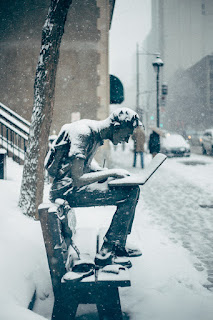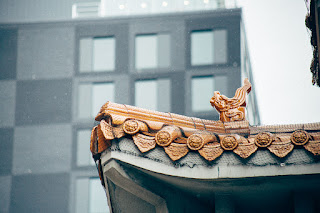sean sayed
Tuesday 20 March 2018
Tuesday 6 March 2018
Tuesday 27 February 2018
CW2 LAB 5
Histogram
Low-Key
High-Key
Variety
a. According to the histogram, where do most of the pixels in your high key image fall (left or right on the histogram)
Most of the pixels fall towards the centre right.
b. Are there any pixels in the high key image that would not print with detail?
There isn't any clipping in the highlights or shadows according to the histogram so it should print all the pixels.
c. According to the histogram, where do most of the pixels in your low-key image fall (left or right on the histogram)
They fall mostly to the left of the histogram.
d. Are there any pixels in the low-key image that would not print with detail?
Yes there are towards the bunny feet but very little the screen isn't picking up the blacks in the image.
e. According to the histogram, where do most of the pixels in your varied tones image fall (left or right on the histogram)
They are spread throughout out the whole histogram but seem to bunch up more towards the left.
f. Are there any pixels in the varied tones image that would not print with detail?
Yes there's clipping in the blacks specifically between the green and brown seamless which wouldn't print.
g. Considering the information on the histogram, do you feel your camera is properly exposing the high key and low-key scenes? Explain your answer
For the low-key everything is well exposed considering the background is dark and the histogram is pushed towards the dark side. For the high-key I could have been a little more exposed because it's an all white scene so the pixels should have been more towards the right instead of the middle.
h. Which histogram shows the most dynamic range?
I think the one with the variety has the most dynamic range, because everything is evenly spread from left to right.
Tuesday 20 February 2018
CW2 LAB 4
The width of the background from wide angle to tele reduces the width of the background. The opposite is true when going from tele to wide angle.
When using a wide angle lens the subject seems far from the background. When using the tele photo lens the subject seems to be compressed to the background.
When shooting wide angle the distance between the subject and background enlarge and in terms of width the subject is slightly expanded. When shooting tele photo the distance between the subject and the background are compacted, the width of the image are contract more, compressing the image more.
- camera approx. 3 meter from subject
- Subject is about 3 meters away from back drop.
- The subject is slightly compressed
- The backdrop takes up most of the background.
Wide Angle: 50mm f/ 1.8 iso 800
- Camera approx. 1.5meter from subject
- Subject is about 3 meters away from back drop.
- The subject is pulled forward more.
- Theres slight distortion in the corners of the image.
- The background is expanded with the wide angle lens taking in more space around the backdrop.
- camera approx. 3 meter from subject
- Subject is about 4 meters away from back drop.
- The subject is compressed
- The backdrop takes up most of the background.
- Camera approx. 1.5meter from subject
- Subject is about 4 meters away from back drop.
- The subject is pulled forward from the background/
- Again theres slight distortion in the corners of the image.
- The background is expanded with the wide angle lens taking in more space around the backdrop. You can see slight distortion in the table and the chair.
Tuesday 13 February 2018
CW2 LAB 3
Lab 3: Noise reduction and WB
ISO 100
I was using a canon 6D
When shooting at ISO 100 either low, standard or high you don't notice that much of a difference. But at ISO 3200 I notice a slight difference between the low and high. It seems as if the low setting seems more grainy when looking at the image as a whole while when shooting with the high setting the image seems a little blended, as seen in the exit sign the box looks a little blurry. The image quality is a lot sharper when shooting on the low setting at iso 3200 but the noise makes it more rough verses the higher setting you loose a little bit of sharpness but the noise is slightly reduced but making the image soft.
Would I use these setting? I would probably use low or standard but not the high setting because of some of the detail loss. The low and standard seem to do a descent job but I wouldn't notice a huge difference is I had these settings on or off.
Would I use these setting? I would probably use low or standard but not the high setting because of some of the detail loss. The low and standard seem to do a descent job but I wouldn't notice a huge difference is I had these settings on or off.
White Balance
All plant images where shot at 1/500 sec at f/ 1.8 iso 400
Auto White Balance
Shade White Balance
Fluorescent White Balance
The library had all kinds of crazy lights going on. There was sun coming out through the window, then the lights from above and finally the pink walls bouncing light all around. The first image was shot using the auto white balance setting. The tones look a little off cause the background seems slightly purple while the plant looks a little orange. I would have needed to do a custom white balance to shoot in the library. The second setting I used was shadow white balance which turned everything orange and when shooting in fluorescent the tones become purple.
Shot at 1/125/ at f/ 1.8, iso 800
I used the outdoor sun white balance to shoot this, the proper setting would have had to be fluorescent. The setting used makes the seen a lot warmer and calm. Would I use the wrong white balance on purpose? Yes, sometimes using the wrong white balance can create some interesting moods in certain scenes.
Tuesday 6 February 2018
CW2 LAB 2
1/2000 SEC AT F/2.0, ISO 100
1/125 SEC AT F/8.0, ISO100
1/15 SEC AT F/22, ISO 100
1/50 SEC AT F/22, ISO 400
1/160 SEC AT F/1.8, ISO 500
1/10 SEC AT F/8.0, ISO 500
Notes: For the still life I find that the image shot at f/1.8 is the nicest because the focus is on the subject and you can shoot at faster shutter speeds freezing the snow in motion and letting more light in.
The same applies to the portraits when the background is blurred the focus is on the subject and not what's around him.
Subscribe to:
Posts (Atom)












































